Gulf of Mexico Oil Spill update for May 5th

The 98-ton, four-story container that BP hopes will take care of the main oil leak was loaded onto a barge in Port Fourchon, La., on Wednesday in preparation for its journey to the well.
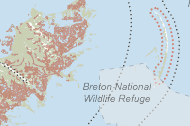
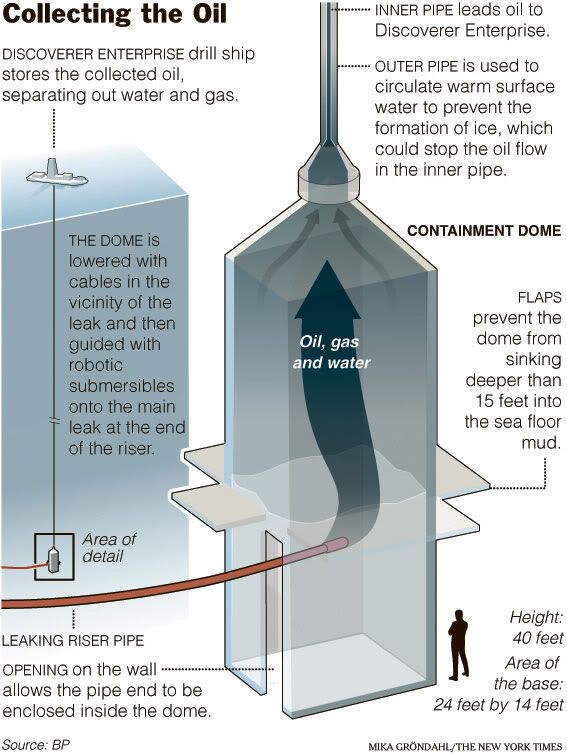
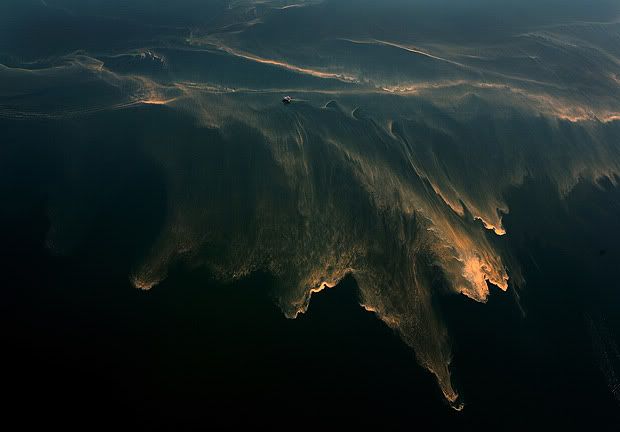
Photo: Oil can be seen less than a quarter mile off of the east side of the Chandeleur Islands, and also on the west side. Small patches of the oil has already hit parts of the land on Chandeleur Island. (Carolyn Cole / Los Angeles Times)
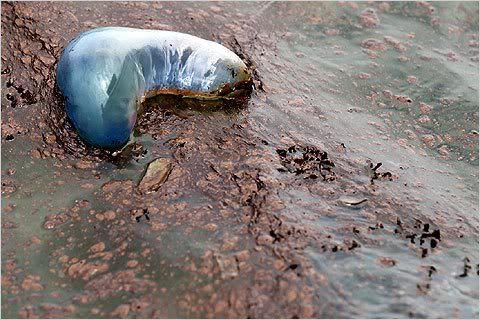
Clumps of oil and a Portuguese-man-of-war in Chandeleur Sound, La., on May 3.

Oil booms wrap around the shore near the South Pass of the Mississippi River on May 4
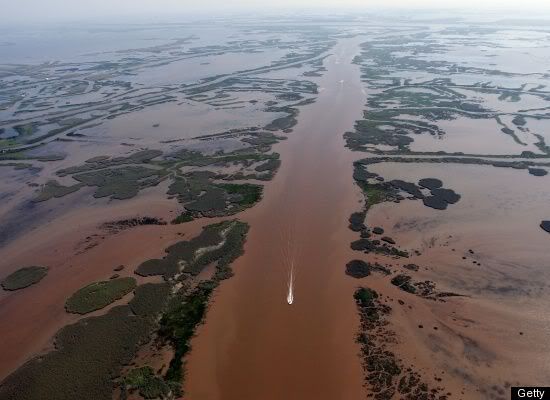
A boat navigates the fragile wetlands near the South Pass of the Mississippi River on May 4.

Boats lay oil booms around one of the Chandeleur Islands off Louisiana to try to keep out approaching oil on May 4.

Fisherman Henry Nunez waits for orders to take out oil booms in Hopedale, Louisiana, on May 4.
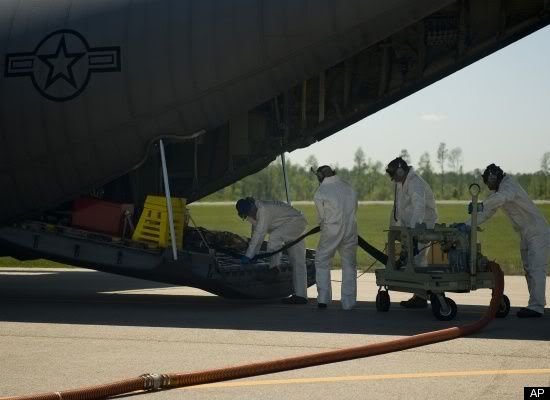
In this image provided by the U.S. Air Force, a team of aerial spray aircraft maintainers from Youngstown-Warren Air Reserve Station in Ohio refill a chemical dispersing C-130 aircraft to be scattered on the oil-affected areas.

In this photo released by the U.S. Coast Guard, workers decontaminate a boom to be put back into use in Venice, Louisiana on May 4.

A rig drills a relief well and support vessel in the Gulf of Mexico on May 4.
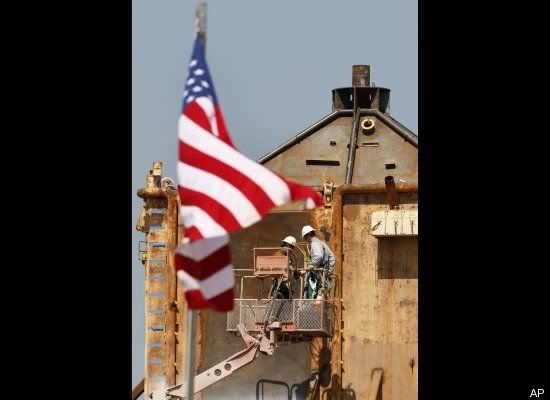
Work continues on one of the domes that will be used to help contain the leaking oil.
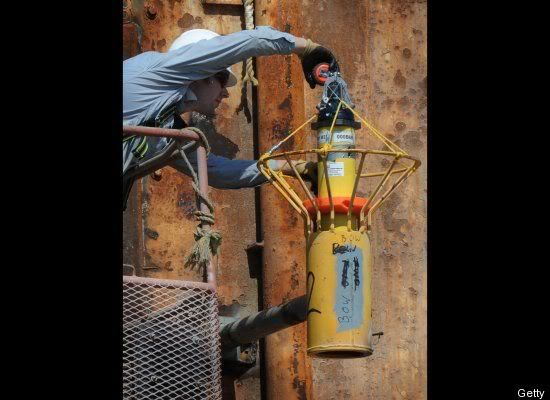
Workers add the finishing touches on the Pollution Control Dome in Port Fourchon on May 4.
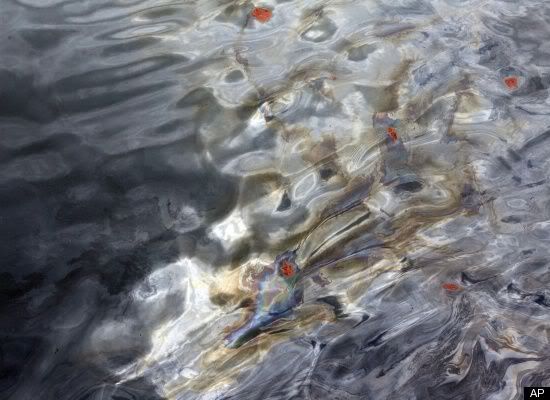
Clumps of oil are visible in the waters off Chandeleur Sound, Louisiana.
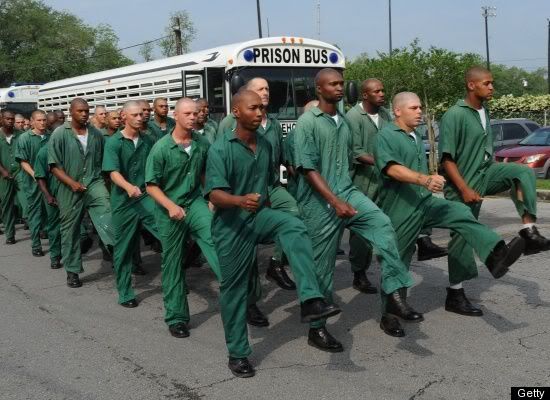
Prisoners from the Elayn Hunt Correctional Center line up as they prepare for training on how to clean oil from birds affected by the spill.
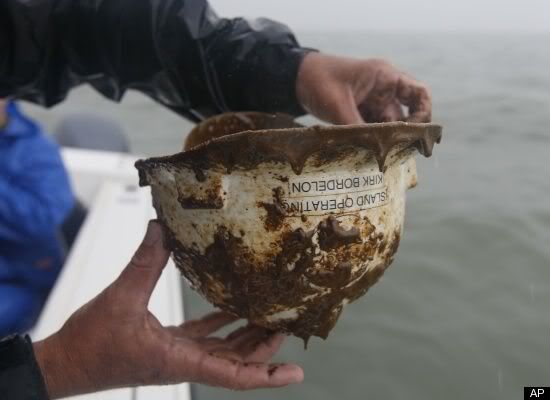
A hard hat covered in oil is found in the waters of Chandeleur Sound, Louisiana.
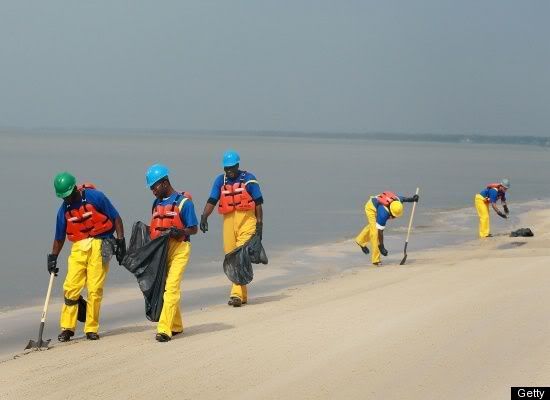
Workers clear the beach of debris as it is prepared for possible contamination in Pass Christian, Mississippi.
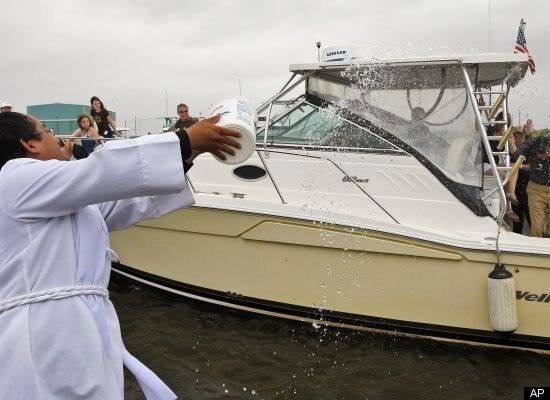
Rev. Luke Nguyen throws holy water at a boat during the annual blessing of the fleet in Chalmette, Louisiana on May 2. In past years, more than 100 boats have attended, but this year there were only three boats and a pirogue.
Gulf oil spill: June hurricanes are a long-term worry
May 5, 2010 | 1:27 pm
Forecaster Joe Bastardi at AccuWeather is starting to raise concerns about any early June hurricanes, as the Caribbean cyclonic season starts. Those storms tend to form in the western Caribbean and drift northward toward the Gulf of Mexico.
Should the oil spill linger in the waters of the gulf during early hurricane seasons, a strong storm could greatly hamper boom operations and drive the oil slick northward toward the shorelines of Louisiana, Mississippi, Alabama and Florida. There even is a possibility of oil droplets becoming airborne and being driven inland.
Bastardi added:
"While the factor of winds, waves and storms makes for a tremendous forecast challenge as to where the oil slick will end up, ocean currents take the problem to a whole new level."
He's referring to the Gulf loop current, which comes up from the Yucatan Peninsula, dips into the Gulf, then sweeps across the southern tip of Florida. Sometimes the loop can spin off small eddy currents in the northern part of the Gulf, near the plume of oil, which now stretches as far east as Pensacola, Fla.
The big worry remains whether the plume or parts of it will get caught up in the loop current and spread across the Everglades and Florida Keys, both of which are ecologically sensitive areas.
-- Geoff Mohan
Gulf oil spill: No evidence of oil in dead turtles
May 5, 2010 | 6:01 pm
Necropsies conducted on 10 of 38 sea turtles found stranded on Gulf Coast beaches since April 30 showed no evidence of oil, externally or internally, federal wildlife investigators said Wednesday.
All of the recovered sea turtles were dead except one, which died shortly afterward, said Barbara Schroeder, the National Oceanic and Atmospheric Administration’s national sea turtle coordinator. “Based on careful examination, NOAA scientists do not believe that these turtle strandings are related to the oil spill,” she said.
The turtles were sent to the Institute for Marine Mammal Studies in Gulfport, Miss. to determine whether their deaths were linked to oil, or some other cause. At least 15 more necropsies of dead sea turtles are scheduled over the next few days.
Sea turtle strandings in Gulf of Mexico are common. However, NOAA scientists said the stranding numbers are higher than normal this year and are working to understand why.
Sheryan Epperly, sea turtle team leader for the National Marine Fisheries Service told the Associated Press that federal investigators will look into whether shrimp boats removed mandated devices, known as turtle excluder devices, or TEDs, that help turtles avoid being trapped in nets. ''The agency has been trying to collect information on not just the trawling fisheries but any other fishing that may have been going on in the area,'' Epperly said. ''If the turtle excluder device is not properly used, then that likely could lead to the deaths of any turtles that get caught in the nets.''
In the meantime, overflights of the oil spill area on Tuesday discovered 30 to 50 sea turtles swimming in or near the oil spill, about 30 to 50 miles off shore. NOAA is developing a plan to deal with large numbers of oiled sea turtles.
Doug Inkley, a senior scientist with the National Wildlife Federation said that even though tests have shown that turtles haven’t been killed by the oil, it doesn’t negate the long-term effects of the spill.
Greenpeace, meanwhile, reported sighting other marine life swimming in the plume of oil that has been spreading in the Gulf of Mexico since April 22. Greenpeace conservation specialist Rick Steiner reported:
“During a plane trip today, I was able to see an extensive area of the spill near the Louisiana shore as well as inside and right off shore of the barrier islands, and washing over and around the submerged Little Gosier Island and Grand Gosier island. We saw countless sharks visible below the surface, swimming beneath the oil, as well as hundreds of stingrays, and a porpoise surfacing through the slick. Some of the oil is now within 2-3 miles of the end of the [Mississippi] river."
--Louis Sahagun and Nicole Santa Cruz
Gulf oil spill: More calls for moratorium on offshore drilling
May 5, 2010 | 4:48 pm
In a rapid legislative response to the Gulf Coast spill, lawmakers on Capitol Hill are seeking to reinstitute a ban on new drilling off the West Coast and fast-track legislation to raise oil company liability for spills.
Meanwhile, no fewer than five congressional committees are gearing up for investigative hearings.
"Enough is enough," Rep. John Garamendi (D-Walnut Creek) declared in a letter to House colleagues seeking support for a bill introduced Wednesday to permanently ban new energy exploration off California, Oregon and Washington state.
“The ‘drill, baby, drill’ crowd has insisted for years that oil drilling from offshore platforms is safe and clean. The millions of Americans who live along the Gulf Coast would now beg to differ,” Garamendi said. “If a similar calamity occurred in federal waters in Southern California, we would see an oil slick spanning the coast from Long Beach to Santa Barbara.’’
Gulf oil spill: BP executive gets shrimper's view up close
May 5, 2010 | 4:39 pm
Doug Suttles, BP's chief operating officer, has become a common face and voice at media briefings about the ongoing oil spill in the Gulf of Mexico.
But perhaps he was lucky one shrimper didn't recognize him.
Suttles recently told of stopping to buy toothpaste in Mobile, Ala. There, he ran into a “large man” in line at the check-out, who asked him if he was with the oil-spill crews, then warned him not to “mess up my shrimp.”
"If you do, I’m gonna come find you,” he said the man told him.
Suttles said he was taking the message to heart.
-- Julie Cart
Gulf oil spill: Missing and presumed dead oil rig workers identified
May 5, 2010 | 11:32 am
Transocean, the company that owned the drilling rig that burned and sunk April 22, sparking the massive oil spill in the Gulf of Mexico, has posted a condolences page for nine of its employees lost in the accident.
Two others worked for M-I Swaco, an oil rig services company.
-- Geoff Mohan
Giant Dome For Gulf Oil Leak Is Best Short-Term Solution
CAIN BURDEAU and HARRY R. WEBER | 05/ 5/10 08:43 PM |
NEW ORLEANS - The oil you can't see could be as bad as the oil you can.
While people anxiously wait for the slick in the Gulf of Mexico to wash up along the coast, globules of oil are already falling to the bottom of the sea, where they threaten virtually every link in the ocean food chain, from plankton to fish that are on dinner tables everywhere.
"The threat to the deep-sea habitat is already a done deal - it is happening now," said Paul Montagna, a marine scientist at the Harte Research Institute for Gulf of Mexico Studies at Texas A&M University-Corpus Christi.
Hail-size gobs of oil the consistency of tar or asphalt will roll around the bottom, while other bits will get trapped hundreds of feet below the surface and move with the current, said Robert S. Carney, a Louisiana State University oceanographer.
Oil has been gushing into the Gulf of Mexico at a rate of at least 200,000 gallons a day since an offshore drilling rig exploded last month and killed 11 people. On Wednesday, workers loaded a 100-ton, concrete-and-steel box the size of a four-story building onto a boat and hope to lower it to the bottom of the sea by week's end to capture some of the oil. Crews also set fires at the worst spots on the surface Wednesday to burn off oil.
Scientists say bacteria, plankton and other tiny, bottom-feeding creatures will consume oil, and will then be eaten by small fish, crabs and shrimp. They, in turn, will be eaten by bigger fish, such as red snapper, and marine mammals like dolphins.
The petroleum substances that concentrate in the sea creatures could kill them or render them unsafe for eating, scientists say.
"If the oil settles on the bottom, it will kill the smaller organisms like the copepods and small worms," Montagna said. "When we lose the forage, then you have an impact on the larger fish."
Making matters worse for the deep sea is the leaking well's location: It is near the continental shelf of the Gulf where a string of coral reefs flourishes. Coral is a living creature that excretes a hard calcium carbonate exoskeleton, and oil globs can kill it.
The reefs are colorful underwater metropolises of biodiversity, attracting sea sponges, crabs, fish, algae and octopus.
"In my mind, they are at least as sensitive to contamination to oil as coastal habitat," said James Cowan, an oceanographer at Louisiana State University. "They are in deeper water, so they are kind of out of sight, out of mind."
There are other important habitats in shallower waters, such as an ancient oyster shell reef off the Mississippi and Alabama coasts. It is a vital nursery ground for red snapper and habitat for sponges, soft corals and starfish.
Scientists are watching carefully to see whether the slick will hitch a ride to the East Coast by way of a powerful eddy known as the "loop current," which could send the spill around Florida and into the Atlantic Ocean. If that happens, the oil could foul beaches and kill marine life on the East Coast.
"Once it's in the loop current, that's the worst case," said Steve DiMarco, an oceanographer with Texas A&M University-College Station. "Then that oil could wind up along the Keys and transported out to the Atlantic."
Engineers are racing to stem the flow of oil before the disaster escalates, mainly by getting ready to place a giant structure on top of the spill to funnel the crude into a tanker. The boat carrying the contraption set sail late Wednesday.
"We're a little anxious," boat captain Demi Shaffer told The Associated Press aboard the vessel just after it set off. "They're gonna try everything they can. If it don't work, they'll try something else." The Associated Press is the only news organization with access to the containment effort in the Gulf.
BP is also exploring a technique in which crews would reconfigure the well that would allow them to plug the leak, but that effort is a couple weeks off.
The cause of the rig explosion is still not known, but investigators from multiple federal agencies are looking into the matter. The rig owner, Transocean, said in a filing with regulators Wednesday that it has received a request from the Justice Department to preserve information about the blast.
The Gulf ecosystem is already stressed by fertilizer and other farm runoff from the Mississippi River and the loss of wetlands to erosion and development. About 2,100 square miles of wetlands have disappeared since the 1930s in the southern Louisiana.
Every summer, algae caused by fertilizer runoff sucks up the oxygen in a large patch of the Gulf, creating a "dead zone" from which all sorts of sea creatures must escape. This year, they will be swimming into waters fouled by the oil spill.
"We're always wondering when we may reach the point where straw breaks the camel's back," Montagna said. "At some point you have to wonder if we will see catastrophic losses."
___
Associated Press Writer Ray Henry contributed to this report from Robert, La. Weber contributed from Port Fourchon, La.
Obama Working With Congress To 'Significantly' Raise BP's Liability
Sam Stein | First Posted: 05- 5-10 12:57 PM | Updated: 05- 5-10 01:56 PM
The president and his team are currently in the process of working with members of Congress to "significantly" raise the amount of money that oil companies like BP would have to pay in economic damages in the event of a spill.
White House Press Secretary Robert Gibbs told reporters on Wednesday that the Office of Management and Budget was working with members to lift the $75 million cap that currently exists on the amount oil companies pay for non-cleanup and containment costs.
Gibbs did not put out a number for where the president would like the new cap to be, saying merely: "We would be in favor of significantly lifting that cap, a cap put in place in the Oil Pollution Act of 1990, so at least 20 years old."
Earlier this week, Sen. Robert Menendez (D-NJ) introduced legislation that would raise the cap to $10 billion. An opponent of offshore drilling, the New Jersey Democrat said that the $1.6 billion that oil companies pay into a trust fund for cleanup and containment costs was "little consolation to the small businesses, fisheries and local governments that will be left to clean up the economic devastation that somebody else caused."
On Wednesday, House Democrats followed suit, with Rep. Rush Holt (NJ) introducing the same bill as Menendez. The effort was co-sponsored by Reps. Suzanne Kosmas (FL), Allen Boyd (FL), Paul Hodes (NH), Kendrick Meek (FL), Artur Davis (AL), Frank Pallone (NJ) and Jay Inslee (WA).
Gibbs neither endorsed nor opposed these bills. But he stressed that BP is "going to get a bill for the recovery of cleanup and the damages caused" by the current spill in the Gulf
Oil Burn On Gulf Coast Starting Today
First Posted: 05- 5-10 12:48 PM | Updated: 05- 5-10 02:03 PM
Gulf Coast relief workers plan to begin Wednesday a controlled burn of certain parts of the massive and still-growing oil spill on open water, according to the Deepwater Horizon Response Joint Information Center.
Though the strategy is designed "to protect shoreline and wildlife," the response unit claims its controlled-burn operations will not affect populated areas, marine mammals or sea turtles. The Environmental Protection Agency will be on hand to ensure that air quality remains within acceptable safety levels.
Barring unforeseen weather problems, this will mark the first controlled burn since April 28, when a 28-minute burn removed what was estimated to be thousands of gallons of oil.
The full statement from the response unit appears below:
ROBERT, La. - Favorable weather conditions have allowed responders to prepare to conduct a controlled burn today, May 5th.
As part of a coordinated response that combines tactics deployed above water, below water, offshore, and close to coastal areas, controlled burns remove oil from the open water in an effort to protect shoreline and wildlife.
No populated areas are expected to be affected by the controlled burn operations and there are no anticipated impacts to marine mammals and sea turtles. In order to ensure safety, the Environmental Protection Agency will continuously monitor air quality and burning will be halted if safety standards cannot be maintained.
A successful controlled burn, lasting 28 minutes and removing thousands of gallons of oil, was conducted on April 28th.
Unable to Stanch Oil, BP Will Try to Gather It
By SAM DOLNICK and HENRY FOUNTAIN
Published: May 5, 2010
BATON ROUGE, La. - With remote-controlled robots a mile underwater unable to seal the gushing well, and with the drilling of relief wells that would allow crews to plug the spouting cavity months away from completion, it is time for the big box.
The end of the oil spill, or at least the end of much of the oil leaking into the Gulf of Mexico, may soon be delivered by a 98-ton steel box standing four stories tall, with a fresh coat of white paint.
The containment dome, as engineers are calling the structure, was built over the past week by a crew of more than two dozen welders working around the clock at a shipyard in Port Fourchon, La. On Wednesday, the dome began its journey to the site of the ruptured well, where it will be lowered by cable 5,000 feet beneath the sea to sit atop the larger of the two remaining leaks.
The dome will not shut off the gushing well, which is still spilling an estimated 210,000 gallons of oil a day; the goal is just to keep some of the oil out of the water by capturing it and then funneling it to a drill ship, called the Discoverer Enterprise, waiting on the surface.
Think of the dome as an inverted cup gathering the gushing oil, and the drill pipe as a straw carrying it to the surface. If it sounds simple, it is not. Containment domes have been used in shallow water, but never at this depth.
“This is new technology,” said Bob Fryar, BP’s senior vice president for operations in Angola, who was brought to Houston for the engineering effort. “It has never been done before.”
BP was leasing the Deepwater Horizon oil rig from the owner, Transocean, when it exploded on April 20. BP officials said they hoped the dome would be working by Monday. If successful, it will remove about 85 percent of the oil spilling into the sea, officials said.
To construct the dome, BP turned to Wild Well Control, a contractor that helps battle oil well disasters. Wild Well Control works in a crisis relief niche that rarely attracts such international attention but often provides high drama.
Despite the hopes placed on the big box, questions remain: Can it withstand the conditions nearly a mile beneath the sea? Will ice plug up the pipe? Will bad weather interrupt the work? Will the combination of gas, oil and water mix uneasily - or explosively - on the ship above? Add global scrutiny to the mix, and you have some anxious engineers.
“I’m worried,” said David Clarkson, BP’s vice president for project execution, “about every part.”
BP engineers in Houston have sketched out models to account for what they expect to happen in this novel approach, along with several contingency plans. To combat the ice, which is likely to form as gas bubbles out of the oil, engineers will inject warm water along the pipe, and methanol into the oil.
But as so many other response efforts so far have shown, engineering problems that can be solved on the ground can prove perilously stubborn 5,000 feet underwater.
“We’ll learn a lot in the first three or four days,” Mr. Clarkson said.
The oil captured in the box can be stored on the Discover Enterprise - more than five million gallons in all - and then offloaded to a standby vessel to be processed, Mr. Clarkson said. It may require special treatment at a refinery before it is reused, he said.
“We know that we can get the fluid into the drill ship,” Mr. Clarkson said. “We don’t know the exact conditions that will arrive in the drill ship.”
On Wednesday, for the first time in several days, cleanup crews were able to conduct a controlled burn in two of the most concentrated areas of the oil spill. Officials also said that engineers had shut off one of the three leaks from the damaged well late Tuesday night, although that did not appear to greatly diminish the overall flow.
Rear Adm. Mary E. Landry of the Coast Guard said the spill was close to the Chandeleur Islands. “But,” she said, “the heavy concentrations are farther offshore.”
BP continued to pursue other ways to bring the well under control soon. One idea being worked on by engineers, Mr. Fryar said, is called a top kill, and involves a heavy liquid being pumped into the well to overcome the pressure of the oil coming from below. That could stop the flow of oil.
Mr. Fryar said a second containment dome was being built to collect oil coming from a leak in the riser, directly above the blowout preventer. But putting the dome over that leak would make it extremely difficult to work on the blowout preventer, so no decision has been made to deploy it yet.
Engineers were continuing to try to get the blowout preventer to activate fully, which would shut off the flow. But after two weeks of futility, Mr. Fryar said, “the possibility of that is lessened.”
Sam Dolnick reported from Baton Rouge, and Henry Fountain from Houston.
Rules, Revolving Doors and the Oil Industry
May 5, 2010, 7:36 pm
A BP executive told members of Congress on Tuesday that the ruptured oil well in the Gulf of Mexico could potentially spill as much as 60,000 barrels a day, more than 10 times the current estimate. With the conditions growing worse by the day, questions about the adequacy and effectiveness of offshore drilling regulations have become more urgent.
Are there rules that Congress should have put in place long ago, but didn’t (some nations like Norway require rigs to be equipped with remote-controlled shut-off switches, which the BP rig did not have)? What’s lacking in the cleanup phase that might have been foreseen before the disaster?
Danielle Brian and Mandy Smithberger, Project on Government Oversight
Tyler Priest, historian
Beverly A. Sauer, Georgetown University
The Capitalist Hagiography Has Little Room for Saints
Stuart Whatley | May 03, 2010
Perhaps the most enervating element of the BP-Deepwater Horizon disaster is its eery familiarity -- the sheer, inexorable predictability of it all. There is poetic injustice in its propinquity on the calendar to the Obama administration's decision to expand offshore drilling last month, and to the Supreme Court decision just this year that further did away with any distinction between 'corporate rights' and 'individual rights'.
Equally predictable is the route the story will take, the revelations that will arise, and the conclusions that will be reached. Talk of lax regulatory standards already runs rampant through a wide array of media outlets. Righteous cries of 'I told you so' resound. Surely this disaster was avoidable...it must have been. But from Goldman Sachs to Massey Energy to -- now -- British Petroleum (and, unsurprisingly, possibly Halliburton), how much will things change? Ultimately the recourse is dictated by the laws we already have in place. And constantly these laws and regulatory structures turn out to have been rendered obsolete and toothless by precisely the entities they purport to oversee.
The gulf story will likely be no more about corporate corner-cutting than a broken political system -- the recurring motif of this year. And regrettably, in a nation that incarcerates people by the hundreds of thousands for victimless crimes of self-indulgence it is yet inconceivable that those who wreck global ecological and financial systems could ever suffer anything exceeding the "cost of doing business." When a corporation falls short of regulatory standards it does not do so accidentally or unwittingly. Rather, it is a calculated choice based on risible enforcement efforts and piddling penalties passed by legislators and public officials on the political take.
Massey Energy's Upper Big Branch explosion that left 29 miners dead last month was a teachable tragic moment. As Mine Safety and Health News's Ellen Smith thoroughly documented here at HuffPost and elsewhere, dozens of past violations did nothing to alter the toxic cynicism that prioritizes profit margin before safety and lives. Whether those pointless deaths and the pressure from survivors' families will yield real changes to that reality is yet to be seen. But either way, the likelihood of true justice for this incident seems low. As Smith writes, "Curiously the only individuals who might be held personally liable under the Mine Act for the current disaster are the mine supervisors and foremen. There are no provisions to hold accountable those people who are responsible for safety policies and procedures, or the corporate executives who insisted it was more important to "run coal" than to build ventilation controls, or the board of directors, which is ultimately responsible for the conduct of the corporation."
Despite lofty guarantees from the president, the same may as well be said for the Deepwater Horizon explosion and its so far cataclysmic aftermath. As the New York Times reports, "Under the law that established the reserve, called the Oil Spill Liability Trust Fund, the operators of the offshore rig face no more than $75 million in liability for the damages that might be claimed by individuals, companies or the government, although they are responsible for the cost of containing and cleaning up the spill."
Beyond the costs of actual clean-up, will BP suffer in the long run? Will Americans stage mass boycotts against the company through consumer discrimination? Will it become the industry pariah that politicians ostracize, even if it provides jobs in their states and districts? Don't count on it. With gasoline prices already on the uptick and likely to rise more going into the summer season the lowest price per gallon will sell, no matter who you are. This is why the greed always pays off, and it is why neither producer nor consumer can realistically be expected to fix things. Solutions must come from an intermediary in the form of good governance.
Unfortunately we can't count much on that these days either. It is little wonder that our regulatory structures are so reliably unreliable. And even if there turns out to have been no regulatory failure in the case of BP, the resolution and restitution regime for disasters of this scale is obviously lacking. The fact that OpenSecrets.org -- the Center for Responsive Politics website that closely tracks political contributions and special interest "heavy hitters" -- is suffering site traffic overloads this week is telling. OpenSecrets does indeed label BP a heavy hitter because in the 2008 election cycle it "contributed half a million dollars to federal candidates. About 40 percent of these donations went to Democrats. The top recipient of BP-related donations during the 2008 cycle was President Barack Obama himself, who collected $71,00." It also reports that in 2009 BP spent $16 million on lobbying and that in the first quarter of 2010 it's already expensed $3.53 million for the same purpose, putting it second behind ConocoPhillips for the industry.
Though it's chump change in BP's overall budget, half a million bucks in an election cycle can go an astoundingly long way. In their "Iceberg Theory of Campaign Contributions," [pdf] Marcos Chamon of the IMF and Ethan Kaplan of Stockholm University explain the power of special interest threats (made far more credible by Citizens United) as a part of lobbying and electioneering. It basically goes as follows: We'll give two-thousand bucks to your reelection campaign, but if we're not pleased with your vote, we'll give your challenger ten. Taking into account the leveraging that goes into these threats (spending $2,000 for $12,000 of influence), $500,000 all of a sudden becomes much, much more. Chamon and Kaplan cite the U.S. sugar industry for their example, which in 1998 turned $2.8 million in campaign contributions into over $1,000,000,000 in federal subsidies. And sugar doesn't even compare to "black gold".
Firms like BP, Massey and Goldman Sachs (to name Public Enemies one, two, and three these days) are the definition of a "special interest". There is no political, ideological or religious component to their wants. It's all about the money, and no potential friend on the Hill is precluded. Legislators from both parties enter office with implicit agreements all the time to include this or that subsidy, or to go soft on this or that regulation to hold up their end of the bargain with their electoral benefactors. And when it's all told one is left with bodies of legislation that appear to be (sometimes actually are) written completely for and by the industry itself.
BP will hang its head for now, but when the class action lawsuits come rolling in from the industries destroyed by Deepwater Horizon don't expect to see an overly munificent defendant ready to make amends. And don't expect it to not scapegoat the owner of the rig, Transocean, Ltd. In the end John Galt will always capitalize and Joe Six-Pack will always look for the best bargain. Ignoring rudimentary economic axioms won't change anything.
If corporations may participate in political expression, will they also be subjected to potential political or criminal repercussions that make the cost of doing certain kinds of business too much to even consider? Will "limited liability" continue to apply to unethical and illegal behavior as well as investment? Will stakeholders such as employees, customers and the surrounding environment be kept in mind alongside profits? The compounded frustration with BP, Massey, Goldman and anyone else lurking behind the next crisis will shunt many important questions like these to the forefront of policy discussions. But in the background will always be the money that oils the gears of a perversely incentivizing political system. Until that sees fundamental change, mine ventilation could easily remain inadequate, remote emergency stop valves optional, and casino-style financial products hidden in the shadows.
Related Readings:
Citizens United, the Roberts Court, and the Future of American Electioneering
Obama's State of the Union Falls Short on Correcting Citizens United
American Plutocracy: Corruption Is In the Eyes of the Beholder
Obama's Agenda: Hope, Change, and Lobby-Cencricity
Follow Stuart Whatley on Twitter: www.twitter.com/stuwhat84
Sex, Lies and Oil Spills
Robert F. Kennedy Jr. | May 05, 2010
A common spin in the right wing coverage of BP's oil spill is a gleeful suggestion that the gulf blowout is Obama's Katrina.
In truth, culpability for the disaster can more accurately be laid at the Bush Administration's doorstep. For eight years, George Bush's presidency infected the oil industry's oversight agency, the Minerals Management Service, with a septic culture of corruption from which it has yet to recover. Oil patch alumnae in the White House encouraged agency personnel to engineer weakened safeguards that directly contributed to the gulf catastrophe.
The absence of an acoustical regulator -- a remotely triggered dead man's switch that might have closed off BP's gushing pipe at its sea floor wellhead when the manual switch failed (the fire and explosion on the drilling platform may have prevented the dying workers from pushing the button) -- was directly attributable to industry pandering by the Bush team. Acoustic switches are required by law for all offshore rigs off Brazil and in Norway's North Sea operations. BP uses the device voluntarily in Britain's North Sea and elsewhere in the world as do other big players like Holland's Shell and France's Total. In 2000, the Minerals Management Service while weighing a comprehensive rulemaking for drilling safety, deemed the acoustic mechanism "essential" and proposed to mandate the mechanism on all gulf rigs.
Then, between January and March of 2001, incoming Vice President Dick Cheney conducted secret meetings with over 100 oil industry officials allowing them to draft a wish list of industry demands to be implemented by the oil friendly administration. Cheney also used that time to re-staff the Minerals Management Service with oil industry toadies including a cabal of his Wyoming carbon cronies. In 2003, newly reconstituted Minerals Management Service genuflected to the oil cartel by recommending the removal of the proposed requirement for acoustic switches. The Minerals Management Service's 2003 study concluded that "acoustic systems are not recommended because they tend to be very costly."
The acoustic trigger costs about $500,000. Estimated costs of the oil spill to Gulf Coast residents are now upward of $14 billion to gulf state communities. Bush's 2005 energy bill officially dropped the requirement for the acoustic switch off devices explaining that the industry's existing practices are "failsafe."
Bending over for Big Oil became the ideological posture of the Bush White House, and, under Cheney's cruel whip, the practice trickled down through the regulatory bureaucracy. The Minerals Management Service -- the poster child for "agency capture phenomena" -- hopped into bed with the regulated industry -- literally. A 2009 investigation of the Minerals Management Service found that agency officials "frequently consumed alcohol at industry functions, had used cocaine and marijuana and had sexual relationships with oil and gas company representatives." Three reports by the Inspector General describe an open bazaar of payoffs, bribes and kickbacks spiced with scenes of female employees providing sexual favors to industry big wigs who in turn rewarded government workers with illegal contracts. In one incident reported by the Inspector General, agency employees got so drunk at a Shell sponsored golf event that they could not drive home and had to sleep in hotel rooms paid for by Shell.
Pervasive intercourse also characterized their financial relations. Industry lobbyists underwrote lavish parties and showered agency employees with illegal gifts, and lucrative personal contracts and treated them to regular golf, ski, and paintball outings, trips to rock concerts and professional sports events. The Inspector General characterized this orgy of wheeling and dealing as "a culture of ethical failure" that cost taxpayers millions in royalty fees and produced reams of bad science to justify unregulated deep water drilling in the gulf.
It is charitable to characterize the ethics of these government officials as "elastic." They seemed not to have existed at all. The Inspector General reported with some astonishment that Bush's crew at the MMS, when confronted with the laundry list of bribery, public theft and sexual and financial favors to and from industry "showed no remorse."
BP's confidence in lax government oversight by a badly compromised agency still staffed with Bush era holdovers may have prompted the company to take two other dangerous shortcuts. First, BP failed to install a deep hole shut off valve -- another fail-safe that might have averted the spill. And second, BP's reported willingness to violate the law by drilling to depths of 22,000-25,000 feet instead of the 18,000 feet maximum depth allowed by its permit may have contributed to this catastrophe.
And wherever there's a national tragedy involving oil, Cheney's offshore company Halliburton is never far afield. In fact, stay tuned; Halliburton may emerge as the primary villain in this caper. The blow out occurred shortly after Halliburton completed an operation to reinforce drilling hole casing with concrete slurry. This is a sensitive process that, according to government experts, can trigger catastrophic blowouts if not performed attentively. According to the Minerals Management Service, 18 of 39 blowouts in the Gulf of Mexico since 1996 were attributed to poor workmanship injecting cement around the metal pipe. Halliburton is currently under investigation by the Australian government for a massive blowout in the Timor Sea in 2005 caused by its faulty application of concrete casing.
The Obama administration has assigned nearly 2,000 federal personnel from the Coast Guard, the Corps of Engineers, the Department of Defense, the Department of Commerce, EPA, NOAA and Department of Interior to deal with the spill -- an impressive response. Still, the current White House is not without fault -- the government should, for example, be requiring a far greater deployment of absorbent booms. But the real culprit in this villainy is a negligent industry, the festering ethics of the Bush Administration and poor oversight by an agency corrupted by eight years of grotesque subservience to Big Oil.
Gulf oil spill: Smallest leak sealed off
May 5, 2010 | 7:22 am
The smallest of the three oil leaks on the floor of the Gulf of Mexico has been sealed off by robot submarines -- a move that doesn't reduce the amount of oil spilling out, but one that should make the overall effort to plug the leak less difficult, a U.S. Coast Guard official said.
The small leak -- the one furthest from the well head --was sealed off with a valve sometime between 6 p.m. CDT Tuesday and 6 a.m. Wednesday morning, U.S. Coast Guard Petty Officer Brandon Blackwell said.
But the two more substantial leaks, which are farther down a collapsed riser, or pipe, that had originally connected the wellhead with the drilling rig, continue to gush oil, and the overall rate of the spill is likely the same. "It's kind of like a garden hose with three leaks in it -- you cut off this leak but you still have two more," Blackwell said.
The oil company BP has begun moving a 125-ton collection device, which resembles a big box, toward the site where the drilling rig Deepwater Horizon exploded April 20 and later sank, causing the massive leak. The company plans to lower the collection device over one of the two leaks, and have it in place by this weekend. If it is successful -- and the company has noted that no one has ever attempted this system at such a depth -- the collection device would funnel the oil into a riser that would carry the oil 5,000 feet to the surface, where it would be collected in a ship and a barge capable of storing 137,000 barrels of oil.
A collection device for the third leak is also under construction, said Marti Powers, a BP spokeswoman. That device could be in place within a week.
According to a press release Sunday on the website of the Joint Information Center, which is staffed by BP and federal officials, the system, if successful, could collect "as much as 85% of the oil rising from the seafloor." Powers could not say Wednesday if that figure referred to a scenario with one collection device in place, or both.
Officials have estimated that the leak is gushing oil at a rate of 5,000 barrels a day. But if things go badly, representatives for the companies worried that that figure could turn into 60,000 barrels a day, or 2.5 million gallons. Just four days at that rate would exceed the amount of oil spilled by the Exxon Valdez off Alaska, the worst spill in U.S. history.
--Richard Fausset
Gulf oil spill: Arctic drilling plans; widow speaks; containment vessel heads to sea
May 5, 2010 | 10:04 pm
With the oil plume billowing across the Gulf of Mexico, attention has turned to plans to begin drilling three wells in the Arctic by this summer. A coalition of major environmental groups asked the federal government to halt drilling in the remote and dangerous waters off the coast of Alaska, warning that a spill there “would far surpass those related to BP’s Deepwater Horizon explosion."
Read the report by Kim Murphy and Jim Tankersley here.
Louis Sahagun had an exclusive interview with the pregnant wife of a worker missing and presumed dead in the explosion that sent the Deepwater Horizon rig to the bottom of the Gulf of Mexico.
Read the report here.
BP floated its giant coffer dam that it hopes to place over one of three leaks on the wreckage from the wellhead blowout spewing at least 200,000 gallons of oil into gulf waters daily.
Read the report by Bettina Boxall and Jill Leovy here.
http://www.guardian.co.uk/world/interactive/2010/apr/29/deepwater-horizon-oil-spill-map
http://www.huffingtonpost.com/2010/05/03/bp-oil-spill-2010-latest_n_561320.html#s87984
LA Times Photo Gallery
http://www.huffingtonpost.com/news/gulf-oil-spill
LA Times Gulf Oil Spill Coverage
WhiteHouse.gov
http://www.epa.gov/bpspill/
http://en.wikipedia.org/wiki/Oil_spill
http://en.wikipedia.org/wiki/Deepwater_Horizon_drilling_rig_explosion#Oil_spill
http://www.huffingtonpost.com/2010/05/05/7-secrets-bp-doesnt-want_n_563102.html
http://www.huffingtonpost.com/2010/04/30/louisiana-oil-spill-2010_n_558287.html
I KNEW that everything could be traced back to past eight fucking years of the fucking Bush administration. Now if only this shit will make the national news.